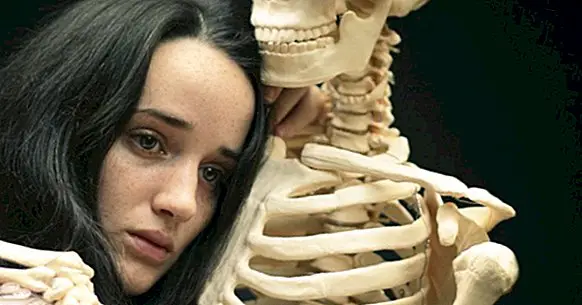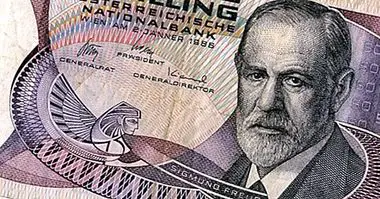Thanatos: what is the death drive according to Sigmund Freud?
Talking about Freud and Freudian psychoanalysis usually implies talking about libido and sexual drive at some point. And is that the father of psychoanalysis considered that psychic life was mainly linked to this type of drive, being the libido the core of psychic life and vital energy.
However, this drive, also called life drive or Eros (in reference to the Greek god), is not the only important one for the author. Throughout his work and as he advanced in the formulation of his theory Freud considered the existence of another type of drive contrary to the first that explains a part of the human psyche Eros fails to close. We are talking about the death drive or Thanatos , about which we are going to talk throughout this article.
- Related article: "Sigmund Freud: life and work of the famous psychoanalyst"
Thanatos as a drive: definition of the death drive
The death drive or Thanatos is a concept developed by Sigmund Freud , which is born in contrast to the life drive or Eros and which is defined as the unconscious impulse and generator of organic excitement (that is, a drive) that appears as the search of being to return to the absolute rest of non-existence. It could be considered as the impulse that seeks the own death and disappearance.
While Eros seeks to unite and preserve life, in addition to satisfying libido , Thanatos seeks to satisfy the aggressive and destructive impulses, having as objective the disunion of the matter and the return to the inorganic state. This impulse often appears in the form of aggressiveness towards others or towards oneself, whether it occurs directly or indirectly. Also while Eros is a force that generates dynamism Thanatos is characterized by generating withdrawal and seeking rest unless it is associated with eroticism.
Thanatos is not guided by the pleasure principle, like Eros, but by the principle of Nirvana: dissolution is sought, reduction and elimination of excitement not to find pleasure in the solution of conflicts that allow survival and conflict resolution but for find it in the dissolution and the return to nothing .
This concept has the peculiarity of being something that is not directly visible: while Eros or libidinous life energy facilitates union and action, Thanatos tends to be shown indirectly through projection, through aggression or through of no action or connection with the world. An example of this is the emission of unhealthy behaviors or the resignation and passive acceptance of some type of aversive event.
- Maybe you are interested: "History of Psychology: authors and main theories"
Pulsional fusion
Eros and Thanatos do not remain as separate drives but they interact continuously, although it's about opposing forces : Eros is a binding force and Thanatos of disunity.
Although part of the death drive remains disjointed, something that generates a gradual drift towards death, the fusion of this with Eros has as a consequence that much of the death drive manifests itself projecting outwards, generating aggressiveness.
Pulsion of death, not always negative
According to the father of psychoanalysis, both the life drive and the death drive are essential for human beings present in a continuous conflict that in many aspects is beneficial for the human being.
Although the idea of the death instinct is controversial and may seem aversive, the truth is that for Freud it is a type of impulse necessary for survival.
On a psychic level, the existence of the death drive allows us to separate ourselves from objects, which in turn makes it possible for us not to identify and psychically merge with them, retaining individuality . There would also be a certain connection with the Oedipus complex, while libidinous and aggressive aspects towards the parents existed.
In addition to this, the aggressiveness resulting from the fusion of both types of drive is advantageous in certain situations, allowing the struggle for survival and self-defense .
Likewise, the conflict between life drive and death drive is also associated with the moment of orgasm, being Eros what makes sexual and erotic satisfaction look but linking the sex itself and the moment of the climax to a discharge, linked to the idea of Rest and return to the baseline and there is a certain aggressive component in it.
In fact authors like Lacan would identify the death drive with the idea of enjoyment, of satisfaction with what should generally cause us displeasure . This partly explains the satisfaction that something such as revenge, sadism or even suffering may be their own or others'.
In pathology
The death drive can be positive, but it can also be reflected in aspects that are not so favorable for the human being.
Freud would come to consider that the concept of guilt would be linked to the death drive , as well as the perseverance of behaviors contrary to health or even the compulsion to repeat unpleasant acts, such as self-injury or different types of compulsive behaviors. Also the emergence of life resignation, despair and apathy can be related to Thanatos, as well as rumination and claudication. Likewise, taken to the extreme, this drive can lead to masochistic attitudes or self-suicidal ideation or attempts.
And not only at the psychopathological level: the emission of anger responses, denial and rejection or even resignation in the presence of difficulties, such as the suffering of chronic diseases, would also be linked to Thanatos. An example of this would be that of do something that we know goes against our health (for example a diabetic eating something that should not, or the fact of smoking in someone with pulmonary emphysema).
Eros and Thanatos: from mythology to Freud
Freud called the life and death drives Eros and Thanatos respectively, in clear reference to Greek mythology. That is why, in order to conclude the article, it can be interesting to analyze the deity that symbolizes them.
Eros is one of the most well-known deities of the Greek pantheon, being the god of love, vitality and amorous passion. In most versions of the Greek myth is the son of the goddess of love Aphrodite and the god of war Ares while in others, according to Plato in "The banquet", is the son of the goddess of poverty Penia and the god of abundance Poros conceived in the celebration of Aphrodite's birthday (something that could be related to different types of love relationships).
Thanatos on the other hand is the god of nonviolent death, son of the goddess of the night Nix and of the darkness, Érebo . This god, twin of Hipnos, the god of the dream, acted with a certain gentleness, being his soft touch and being in charge of fulfilling the will of the moiras regarding the destiny of the mortals when the time came. Despite this, it was a feared being and a force of disunity with life, also linked to the resignation to die.
This description can make us see some of the main attributes of life or death drives. But mythology allows us to see not only that the attributes associated with these gods are antagonistic but also that There are some myths about the conflict between them . One of them is linked to the death of Nymph Ninfea.
The myth tells us that Eros, god of love and in some versions of eroticism and passion, tended to approach and incite the goddess Artemis (goddess of hunting as well as virginity) and nymphs (also virginal), to what the goddess responded by distancing him with his dates. Tired of it Eros decided to throw one of his arrows of love to the goddess in order to make him fall in love, but after being the arrow dodged by Artemis this was to hit on one of the nymphs, Ninfea.
The nymph began to experience a high level of sexual desire and excitement, in an uncontrolled way, arising a strong conflict between that desire and the chastity that was his own. This conflict caused him such distress that he decided to seek liberation in death, throwing himself into the waters of a lake to drown himself. At that time Eros would try to save her, but was stopped by the god of nonviolent death, Thanatos. Because of that Ninfae drowned, being later transformed by Artemis into the first water lily and receiving the gift of reducing passion.
This myth (which has different versions), accounts for the interaction and conflict between the vital and destructive energy that is part of our psyche, according to Freudian theory.
Bibliographic references:
- Corsi, P. (2002). Preliminary approach to the concept of Freud's death drive. Chilean Journal of Neuropsychiatry, 40: 361-70.
- Freud, S. (1976). Beyond the pleasure principle OC XVIII 1920; 1-62.



















